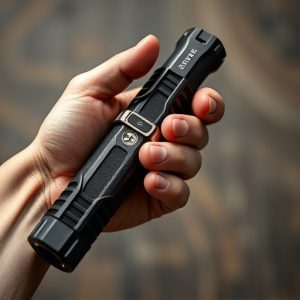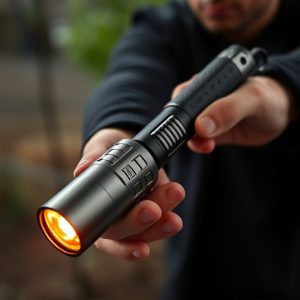Mastering the Self-Defense Expandable Baton: A Legal and Practical Guide
A self-defense expandable baton serves as a personal protection device that balances compactness fo…….
A self-defense expandable baton serves as a personal protection device that balances compactness for easy carrying with the ability to deliver significant force upon extension. When choosing one, prioritize material quality, such as aluminum or stainless steel, and ensure it has reliable locking mechanisms in both open and closed states, as well as a durable impact surface for safety and effectiveness. It should be operationally simple, intuitive under pressure, and equipped with safety features like a training mode or lock to prevent accidental deployment. The baton must deploy and retract swiftly, adhere to local legal length limits, and provide a non-slip grip. Users must be well-informed about the legal use of expandable batons in self-defense within their jurisdiction, understanding that the use of force should be proportional to the threat and that violence should be a last resort. It's essential to engage in specialized training with the baton and complete a certified self-defense course, ensuring proper handling and legal awareness. Users must avoid unnecessary aggression, strike at larger muscle groups if confronted, and always be prepared to articulate their actions to law enforcement if necessary, operating within the confines of the law at all times.
When personal safety becomes a priority, understanding the role of a self-defense expandable baton can be pivotal. This article serves as a definitive guide to navigating the features, benefits, and legal considerations of deploying an expandable baton in self-defense scenarios. From the mechanics that make it an effective deterrent to the critical laws governing its use, this comprehensive overview ensures you are well-informed on selecting and wielding your self-defense expandable baton responsibly and effectively.
Understanding the Self-Defense Expandable Baton: A Comprehensive Guide
When considering a personal protection device, the self-defense expandable baton emerges as a versatile and effective tool. Unlike its fixed-length counterparts, this baton’s design allows it to retract into a compact form, making it an ideal choice for those who prioritize convenience and portability without compromising on defense capabilities. The expandable nature of the baton ensures that it can be easily carried and stored, while still offering a force multiplier during confrontations. Its deployment is swift, extending to a length capable of delivering significant impact, thereby deterring potential threats or incapacitating an aggressor.
Selecting the right self-defense expandable baton involves understanding its components and mechanisms. Key features to consider include material durability, locking mechanisms that secure the baton in both extended and retracted states, and the quality of the impact surface for maximum effectiveness. Additionally, the ease of operation is paramount; a reliable self-defense expandable baton should be simple to extend and retract under stress, with clear instructions for use. Safety measures are also crucial; a training mode or safety lock can prevent accidental deployment, ensuring that the baton is ready for self-defense when needed most. Understanding these aspects will empower users to select a self-defense expandable baton that aligns with their personal protection needs and legal requirements of their jurisdiction.
Key Features and Considerations When Selecting a Self-Defense Expandable Baton
When considering a self-defense expandable baton, it’s crucial to evaluate several key features that can impact both its effectiveness and your ability to handle it with confidence. The material from which the baton is made should be of high strength-to-weight ratio, typically aluminum or stainless steel, to ensure durability without adding unnecessary heft. Look for a model that offers quick and easy deployment, allowing you to extend or retract the baton swiftly in response to a threat. This feature is particularly important when every second counts.
The length of the baton when fully extended should be sufficient to maintain a safe distance from an attacker while still being compact enough for easy carriage. Most jurisdictions have legal limits on the length of an extendable baton, so it’s essential to comply with these regulations. Additionally, consider the baton’s grip; a non-slip design will enhance control and accuracy during confrontations. Safety features such as a locking mechanism that prevents accidental deployment are also vital for both your safety and the safety of those around you. Lastly, familiarize yourself with the legalities of using an expandable baton in self-defense in your area, ensuring you’re fully aware of the consequences and guidelines before making a purchase.
Legal Aspects and Best Practices for Using an Expandable Baton in Self-Defense Situations
When considering a personal protection baton, it’s crucial to understand the legal framework governing its use in self-defense situations. Laws vary by jurisdiction, so individuals must familiarize themselves with local regulations. In many areas, the expandable baton is a permissible self-defense tool provided it’s used lawfully and responsibly. The legal aspects of using such a device emphasize the importance of proportionality and the avoidance of unnecessary force. Self-defense laws typically allow for the use of force that is reasonable under the circumstances to protect oneself from harm. Users should only deploy the baton when there is an imminent threat, and they have attempted to retreat or de-escalate the situation if possible.
Best practices for using an expandable baton in self-defense situations include training with the device to ensure proficiency in its operation. It’s advisable to take a certified self-defense course that covers baton techniques and legal considerations. Maintaining the baton in a non-threatening manner until actual danger is present helps avoid misinterpretation by potential attackers or law enforcement. In the event of an encounter, aim for the assailant’s larger muscle groups rather than delicate areas to minimize the risk of serious injury. Always be prepared to explain your actions to authorities if necessary, as consistent adherence to the rule of law is paramount in self-defense scenarios involving a personal protection expandable baton.


